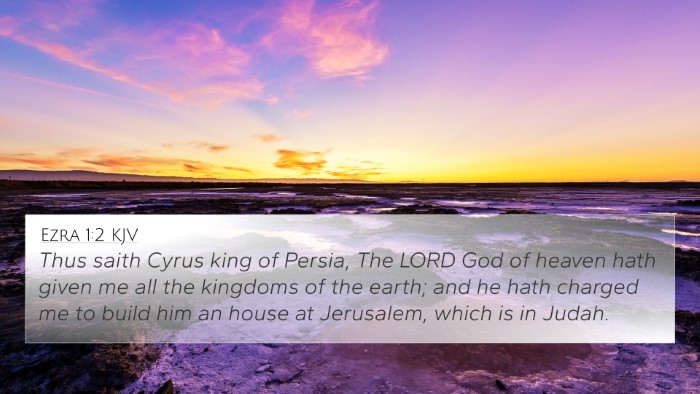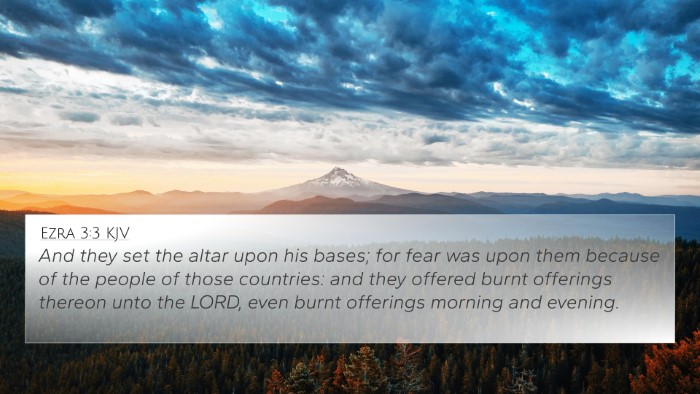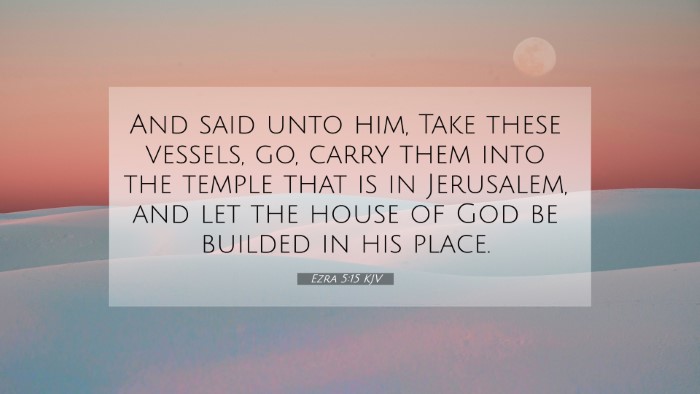Old Testament
Genesis Exodus Leviticus Numbers Deuteronomy Joshua Judges Ruth 1 Samuel 2 Samuel 1 Kings 2 Kings 1 Chronicles 2 Chronicles Ezra Nehemiah Esther Job Psalms Proverbs Ecclesiastes Song of Solomon Isaiah Jeremiah Lamentations Ezekiel Daniel Hosea Joel Amos Obadiah Jonah Micah Nahum Habakkuk Zephaniah Haggai Zechariah MalachiEzra 5:15 Similar Verses
Ezra 5:15 Cross References
And said unto him, Take these vessels, go, carry them into the temple that is in Jerusalem, and let the house of God be builded in his place.
Uncover the Rich Themes and Topics of This Bible Verse
Listed below are the Bible themes associated with Ezra 5:15. We invite you to explore each theme to gain deeper insights into the Scriptures.
Ezra 5:15 Cross Reference Verses
This section features a detailed cross-reference designed to enrich your understanding of the Scriptures. Below, you will find carefully selected verses that echo the themes and teachings related to Ezra 5:15 KJV. Click on any image to explore detailed analyses of related Bible verses and uncover deeper theological insights.

Ezra 1:2 (KJV) »
Thus saith Cyrus king of Persia, The LORD God of heaven hath given me all the kingdoms of the earth; and he hath charged me to build him an house at Jerusalem, which is in Judah.

Ezra 3:3 (KJV) »
And they set the altar upon his bases; for fear was upon them because of the people of those countries: and they offered burnt offerings thereon unto the LORD, even burnt offerings morning and evening.

Ezra 6:3 (KJV) »
In the first year of Cyrus the king the same Cyrus the king made a decree concerning the house of God at Jerusalem, Let the house be builded, the place where they offered sacrifices, and let the foundations thereof be strongly laid; the height thereof threescore cubits, and the breadth thereof threescore cubits;
Ezra 5:15 Verse Analysis and Similar Verses
Understanding Ezra 5:15
Ezra 5:15 states: "And say to him, 'Take these vessels; go, put them in the temple that is in Jerusalem, and let the house of God be rebuilt on its site.'" This verse is part of a crucial moment in the rebuilding of the Jewish temple after the Babylonian exile. To grasp its meaning, we can draw insights from various public domain commentaries, highlighting the significance of the temple's restoration, the authority of King Darius, and the divine command to rebuild.
Overview of the Verse
The context of Ezra 5:15 is rooted in the early efforts of the Jewish exiles to rebuild their temple. The people faced opposition, yet they were inspired by the prophetic encouragement of Haggai and Zechariah. This verse specifically refers to a directive given to a leader named Tattenai by the Persian king. The phrase "let the house of God be rebuilt" underscores the importance of worship and the centrality of God's presence among His people.
Insights from Commentaries
-
Matthew Henry:
Henry emphasizes the faithfulness of God in preserving the vessels of worship from the previous temple. These vessels symbolize both the continuity of worship and God's covenant with Israel. The command to reestablish the temple signifies not just a physical rebuilding but also a restoration of worship and community identity.
-
Albert Barnes:
Barnes notes the significance of the Persian approval for the Jewish endeavor. His commentary highlights how the king's decree was essential for the Jews to feel legally justified in their efforts. The mention of "these vessels" also signifies the importance of holy items in temple worship, which were to be returned to their rightful place.
-
Adam Clarke:
Clarke elaborates on the historical context, explaining that the decree to rebuild wasn't merely about restoration; it was a fulfillment of prophetic promises. He discusses the theological implications, linking this act of rebuilding with the hope of redemption and renewal among the Jewish people after a period of exile.
Thematic Connections
The themes in Ezra 5:15 connect to numerous other scriptures, showcasing a broader biblical narrative related to restoration, worship, and obedience to God. Here are some related verses:
- 2 Chronicles 36:22-23: This passage records the Persian king's decree to rebuild Jerusalem, which is a foundational background for Ezra’s work.
- Haggai 1:2-8: The prophet Haggai’s exhortation to the people to prioritize God's house indicates the urgency and importance of rebuilding.
- Zechariah 1:16: This verse reminds us that God has a plan to return His people to their land, reinforcing the importance of the temple’s restoration.
- Isaiah 44:28: Highlights God’s designation of Cyrus as his shepherd, affirming the divine orchestration behind the rebuilding efforts.
- Nehemiah 2:17: Nehemiah’s call to action works in tandem with Ezra, as both leaders inspire the community towards rebuilding both the walls and the temple.
- Psalm 126:1-3: This psalm reflects the joy of restoration, which parallels the sentiments of the Jewish community during the rebuilding period.
- Luke 19:46: Jesus references the temple as a house of prayer, reiterating its significance through the New Testament lens.
Cross-Referencing Biblical Texts
Understanding Ezra 5:15 through cross-references enhances our comprehension of God's ongoing relationship with His people and the importance of the temple in both historical and spiritual contexts. This verse acts as a pivotal point in the narrative of restoration and serves as a reminder of sacred commitments.
Application of Cross-Referencing Tools
For individuals engaging in a deeper study of the Bible, utilizing tools for cross-referencing can be invaluable. A Bible concordance can help identify meaningful connections, while a cross-reference Bible study guide may provide structured insights. Understanding how these verses relate enables believers to appreciate the intricate web of themes woven throughout Scripture, highlighting God's faithfulness and active engagement in restoration.
Conclusion
Ezra 5:15 encapsulates a significant moment in biblical history, filled with lessons about faith, obedience, and restoration. By examining this verse alongside related scriptures, we can uncover layers of meaning that speak not just to the past but to our present walk with God. The rebuilding of the temple was more than restoring a building; it was about rekindling a community’s covenant relationship with their Creator.
Further Reflections
Exploring the connections between Old and New Testament teachings through Ezra 5:15 enhances our understanding of God’s overarching narrative. Identifying these parallels can enrich personal study, sermon preparation, and communal worship as we seek to understand God’s purpose through the ages.


